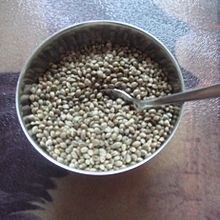Hemp oil: Difference between revisions
m Remove 'merge with hemp' tag, the precendents (olive/ olive oil, corn/ corn oil) suggest the separation is warranted. |
|||
| Line 48: | Line 48: | ||
==References== |
==References== |
||
{{reflist}} |
{{reflist}} |
||
[http://www.cannabis-cosmetics.com/hemp-oil/d-70287/ Hemp seed oil]wonderful nutty flavor and scent - recommended for cold.cooking, flavor-enhancing and balanced human diet - contains perfectly balanced 3:1 ratio of Omega 6 to Omega 3 essential fatty acids -bioactiv and most complex source of phytosterols, vitamins, antioxidants, minerals (K, Ca, Fe, Mg) and chlorophyll |
|||
{{fatsandoils}} |
{{fatsandoils}} |
||
Revision as of 12:30, 20 November 2010

Hempseed oil is pressed from the seed of the hemp (cannabis) plant irrespective of the strain of cannabis. Cold pressed, unrefined hemp oil is dark to clear light green in color, with a pleasant nutty flavor. The darker the color, the grassier the flavour.
Refined hempseed oil is clear and colorless, with little flavour and lacks natural vitamins and antioxidants. Refined hempseed oil is primarily used in body care products. Industrial hempseed oil is used in lubricants, paints, inks, fuel, and plastics. Hempseed oil has found some limited use in the production of soaps, shampoos and detergents. The oil is of high nutritional value because its 3:1 ratio of omega-6 to omega-3 essential fatty acids, which matches the balance required by the human body.[1] It has also received attention in recent years as a possible feedstock for the large-scale production of biodiesel.[2] There are a number of organisations that promote the production and use of hempseed oil.[3]
Hempseed oil is manufactured from varieties of Cannabis sativa that do not contain significant amounts of THC, the psychoactive element present in the cannabis plant. This manufacturing process typically includes cleaning the seed to 99.99% before pressing the oil. There is no THC within the hempseed, although trace amounts of THC may be found in hempseed oil when plant matter adheres to the seed surface during manufacturing. The modern production of hempseed oil, particularly in Canada, has successfully lowered THC values since 1998.[4]
Hash oil is made from the bud and leaves of the cannabis plant. Hash oil, not to be confused with hempseed oil, contains a much higher THC content and is known to have greater medicinal properties than that of hempseed. Hash oil is made by extracting the THC from the cannabis plant, and producing an oil so that the THC can be taken orally, used topically, or vaporized instead of smoked to produce psychoactive effects. The medicinal benefit of the oil is currently under study but it has shown great results related to the treatment of cancers and diseases. Hash oil is considered a Schedule I drug in the United States as a result of the 1937 Marihuana Tax Act. Hash oil containing psychoactive cannabinoids should never be referred to as 'hemp oil', as the modern usage of the word 'hemp' is reserved for plants that meet the legal requirement of containing 0.3% THC or less. [citation needed]
Nutrition
About 30–35% of the weight of hempseed is an edible oil that contains about 80% as essential fatty acids (EFAs); i.e., linoleic acid, omega-6 (LA, 55%), alpha-linolenic acid, omega-3 (ALA, 22%), in addition to gamma-linolenic acid, omega-6 (GLA, 1–4%) and stearidonic acid, omega-3 (SDA, 0–2%).
The proportions of linoleic acid and alpha-linolenic acid in one tablespoon per day (15 ml) of hempseed oil easily provides human daily requirements for EFAs. Unlike flaxseed oil, hempseed oil can be used continuously without developing a deficiency or other imbalance of EFAs. This has been demonstrated in a clinical study, where the daily ingestion of flaxseed oil decreased the endogenous production of GLA.[5]
In common with other oils, hempseed oil provides 9 kcal/g. Compared with other culinary oils it is low in saturated fatty acids.[6]
Highly unsaturated oils, and especially poor quality oils, can spontaneously oxidize and turn rancid within a short period of time when they are not stored properly; i.e., in a cool/cold, dark place, preferably in a dark glass bottle. Hempseed oil can be frozen for longer periods of storage time. Preservatives (antioxidants) are not necessary for high quality oils that are stored properly.
Hempseed oil has a relatively low smoke point and is not suitable for frying. Hempseed oil is primarily used as a food oil and dietary supplement, and has been shown to relieve the symptoms of eczema (atopic dermatitis).[7]
See also
References
- ^ "Hemp Oil". InnVista. November 2005. Retrieved 2006-11-18.
{{cite web}}: Check date values in:|date=(help) - ^ Agua Das (November 16, 1997). "Hemp Oil Fuels & How to Make Them". HempFarm.com. Retrieved 2006-11-18.
- ^ "Hemp Farm". Retrieved 2006-11-18.
- ^ Holler JM, et al.(2008) delta-9-Tetrahydrocannabinol Content of Commercially Available Hemp Products. Journal of Analytical Toxicology 32: 428-432
- ^ Schwab U, Callaway J, Erkkilä A, Gynther J, Uusitupa M, Järvinen T (2006). Effects of hempseed and flaxseed oils on the profile of serum lipids, serum total and lipoprotein lipid concentrations and haemostatic. European Journal of Nutrition 45(8):470-7.
- ^ King's College Review of Nutritional Attributes of Cold Pressed Hemp Seed Oil
- ^ Callaway, JC, Schwab U, Harvimaa I, Halonen P, Mykkänen O, Hyvönen P & Järvinen T (2005). Efficacy of dietary hempseed oil in patients with atopic dermatitis. Journal of Dermatological Treatment 16: 87-94.
Hemp seed oilwonderful nutty flavor and scent - recommended for cold.cooking, flavor-enhancing and balanced human diet - contains perfectly balanced 3:1 ratio of Omega 6 to Omega 3 essential fatty acids -bioactiv and most complex source of phytosterols, vitamins, antioxidants, minerals (K, Ca, Fe, Mg) and chlorophyll
